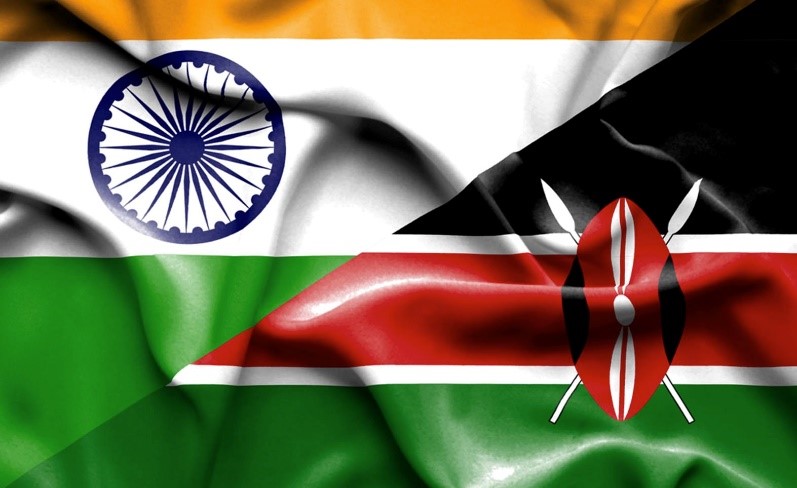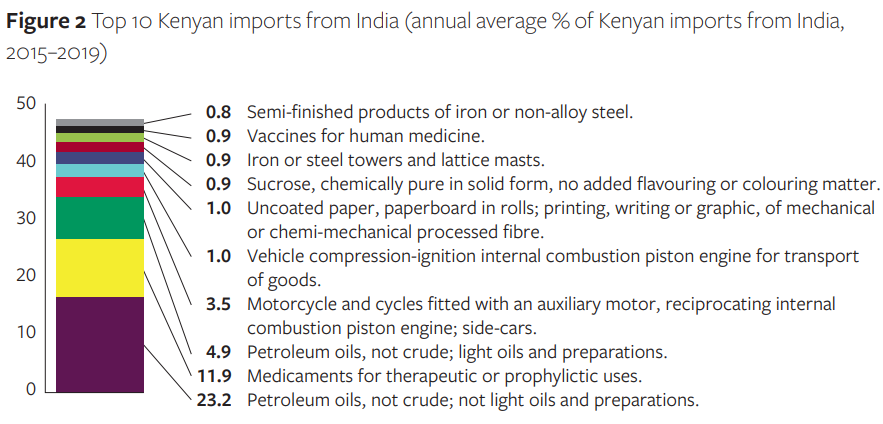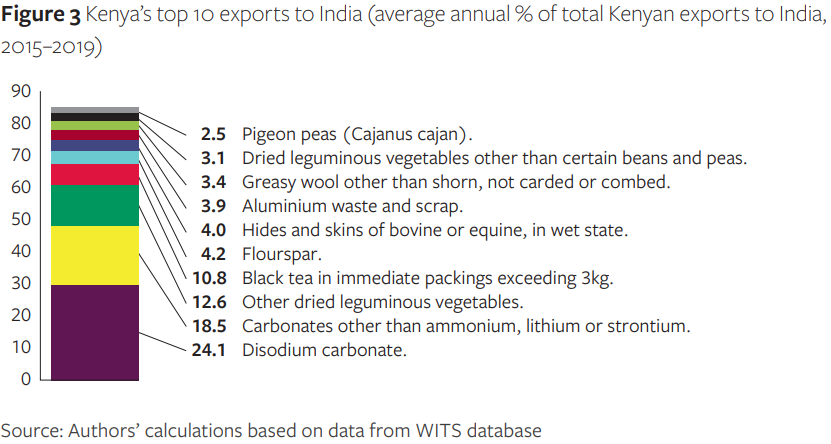Description

Disclaimer: Copyright infringement not intended.
Context
- Goa Shipyard Ltd. and Kenya Shipyard Ltd. signed a memorandum of understanding (MoU) on Tuesday for capacity building and collaboration in ship design and construction.
India Kenya Relations
- India and Kenya are maritime neighbors with robust and multi-faceted partnerships, marked by regular high-level visits, increasing trade and investment, and extensive people-to-people contacts.
History
- As littoral states of the Indian Ocean, trade links and commercial ties between India and Kenya go back several centuries. Kenya has a large minority of Indians and Persons of Indian Origin living there who are descendants of laborers who were brought in by the British to construct the Uganda Railway.
- Prior to India's independence, the welfare of Indians in Southeast Africa gained the attention of Indian freedom fighters. Sarojini Naidu chaired the Mombasa session of the East African Indian Congress in 1924 and a fact-finding mission under K.P.S. Menon was sent there in 1934.
Political Relations:
- India established the office of Commissioner for British East Africa resident in Nairobi in 1948. Following Kenyan independence in December 1963, a High Commission was established. India has had an Assistant High Commission in Mombasa.
- In 2016 leaders of both countries witnessed the signing of seven (MoUs)/Agreements in the fields of defence, trade and developmental assistance.
- PM handed over 30 field ambulances for the use of the Kenya Defence Forces.
- PM and President Kenyatta addressed an India-Kenya Business Forum.
- India announced gifting of a state-of-the-art made in India cancer therapy machine – Bhabhatron II – to Kenyatta National Hospital, grant of US$ 1 million for the refurbishment of the Mahatma Gandhi graduate library of the University of Nairobi and holding of the first-ever Festival of India in Kenya.
- In 2017, President Kenyatta attended the Vibrant Gujarat Summit and a business forum in Delhi.
- MoU on Cooperation in the agriculture sector and allied sector and LoC for US$100 million for agricultural mechanization was signed during the visit.
- Earlier, President Uhuru Kenyatta attended the 3rd India-Africa Forum Summit and held a bilateral meeting with PM Modi in October 2015.
International Collaboration
- Kenya and India are members of international fora like United Nations, Non-Aligned Movement, Commonwealth of Nations, G-77 and G-15 and the Indian Ocean Rim Association for Regional Cooperation and often cooperate with each other on these fora.
Trade and Economy
- India-Kenya Trade Agreement was signed in 1981, under which both countries accorded Most Favoured Nation status to each other.
- The India-Kenya Joint Trade Committee (JTC) was set up at Ministerial level in 1983 as a follow-up to the Agreement.
- According to the Kenya Investment Authority (KenInvest), India is the second largest investor in Kenya. Over 60 major Indian companies have invested in various sectors including manufacturing, real estate, pharmaceuticals, telecom, IT & ITES, banking and agro-based industries. Indian investments have resulted in creation of thousands of direct jobs to Kenyans. Indian pharmaceutical companies have a substantial presence in Kenya.
- A bilateral Double Taxation Avoidance Agreement (DTAA) was signed in 1989. Revised DTAA was signed in July 2016 and came into force on 30 August 2017.
- A Joint Business Council (JBC) was set up in 1985 by the Federation of Indian Chambers of Commerce & Industry (FICCI) and the Kenya National Chamber of Commerce & Industry (KNCCI). FICCI and KNCCI signed a fresh MoU in January 2017 on the sidelines of the Business Forum during the State visit of President Uhuru Kenyatta.
- Kenya has been a net importer of India in the past few years. Growth of exports has been volatile, while imports have marginally declined more recently, narrowing the goods trade deficit from $2.5 billion in 2015 to $1.7 billion in 2019.
- Ten products accounted for 50% of Kenya’s total imports from India in the past five years – dominated by petroleum oils (not containing biodiesel, not crude, not waste oils) of both light (4.9%) and not light oils and preparations (23%), and medicaments for retail sale (12%).
- The major exports to India are mainly agricultural products. They include: Metallic, tea, leather, coffee, non-ferrous base metal waste and scrap metal, wool and animal hair. There is need to diversify Kenya’s exports to include non-perishables such as minerals.
- The major imports from India include: Petroleum oils and oils obtained from bituminous minerals, Medicaments (including veterinary medicaments), Motorcycles, Paper and paperboard, Sugars, molasses and honey, Food-processing machines, other machinery and equipment specialized for particular industries, and structures and parts of structures.


Indian Diaspora
- The most significant aspect of Kenya is the presence of a vibrant and huge Indian Diaspora. The presence of diaspora in Kenya can be traced back to the 17th century.
- Despite their long history of existence in the country and their contribution in the socio-economic and political life of Kenya, the Indian diaspora did experience hardship in the political and historical discourse of the nation. In the economic field, the diaspora has enjoyed economic success.
- The Kenyan government in 2017, recognised the Indian descent as the 44th tribe in the country. The motive behind this move was to strengthen their relationship.
- Today, the Indian diaspora in Africa is seen as a crucial part of the socio-economic framework, contributing immensely to the Kenyan economy. Both countries have also continued to collaborate in many areas – many Kenyans come to India for higher education, while others travel to India for medical purposes. The Indian origin presently numbers around 80,000, including an estimated 20,000 Indian citizens in the country (MEA 2021).
- Several initiatives have been taken by the Indian government to connect the varied diaspora in not only Kenya but across Africa. Some of the initiatives include Pravasi Bharatiya Divas conventions, scholarship programs for diaspora students, programs like Know India Programme, e-VidyaBharti (Tele-education), and e-ArogyaBharti (Tele-medicine) and many more. The diaspora has also been supportive and a key stakeholder in the OCI scheme.
- Kenya is a key strategic partner for India, and the presence of a significant Indian diaspora, combined with the shared colonial legacy, and their mutual interest in establishing security and stability of the Western Indian Ocean binds them together.
Investments
- Tata Chemicals Ltd. acquired Magadi Soda Company Limited in 2005. Several leading Indian public sector insurance companies participate in KenIndia Assurance Co. Ltd. More recent investments by Indian corporates in businesses in Kenya include Essar Energy (petroleum refining), Bharti Airtel, Reliance Industries Ltd. (petroleum retail); Tata (Africa) (automobiles, IT, pharmaceuticals, etc.). Several Indian firms including KEC, Karuturi Ltd., Kalpataru Power Transmission Ltd., Power Grid Corporation of India Ltd., Kirloskar Brothers Ltd., Mahindra & Mahindra, Thermax, WIPRO, Jain Irrigation System Ltd., Punj Lloyd, VIL Ltd., Emcure, Dr. Reddy, Cipla, Cadila, TVS and Mahindra Satyams, etc., have a business presence in Kenya as do the Bank of India and the Bank of Baroda. HDFC and the Central Bank of India have Representative Offices in Kenya.
- An India-Kenya Double Taxation Avoidance Agreement (DTAA) was signed in 1989. The 2nd round of negotiations to review the DTAA was held in Nairobi in November 2010.
Connectivity and Travel
- Air India’s operations to Nairobi via Aden, which began on January 21 1951, the carrier’s second overseas route after London, ended in January 2010 and Air India closed its Nairobi office in March 2011. Kenya Airways flies to Mumbai. Kenya Airways signed a code-share agreement with Jet Airways in 2010. Foreign airlines also provide air connectivity via Doha, Dubai, Abu Dhabi and Sharjah.
- Many Kenyans live and study in India. Nearly 18,000 visas for India are issued annually. Many Indians travel to Kenya for tourism as well as on business.
Academic and Cultural Links
- Government of India offered over 164 scholarships to Kenyan nationals in 2014-15. These include scholarships for professional training in various fields under the Indian Technical & Economic Cooperation (ITEC) Programme and related schemes and Indian Council of Cultural Relations scholarships. A Cultural Cooperation Agreement was signed in 1981.
- Kenya sent its largest-ever sporting contingent to the 19th Commonwealth Games 2010 at New Delhi.
- The late Kenyan Nobel Peace laureate and environmentalist Prof. Wangari Maathai had been conferred the 2005 Jawaharlal Nehru Award for International Understanding in March 2007 by the President, Shri APJ Abdul Kalam as well as the 2006 Indira Gandhi Award for Peace, Disarmament and Development by the President, Smt. Pratibha Patil in November 2007.
Development Cooperation
- India offers development assistance to Kenya in the form of loans and credit. This includes a loan of Rs. 50 million to Government of Kenya in 1982 and Lines of Credit by EXIM Bank to Industrial Development Bank Capital Ltd.
- An Agreement on extension of a Line of Credit of US$ 61.6 million by EXIM Bank of India to the Government of Kenya for utilization in the power transmission sector was signed during the visit of Prime Minister Raila Odinga to India in November 2010.
- In April 2015, GOI approved US$100 million LOC to Government of Kenya for Agricultural Mechanisation Project.
- In 1998, an MoU was signed between the National Small Industries Corporation and Kenya Industrial Estates Ltd. In 2003, an MoU was signed between India Trade Promotion Organisation and Export Promotion Council of Kenya.
- An Agreement was signed in July 2009 between TCIL and the Kenyan Ministry of Information and Communication regarding the project. Equipment was delivered by TCIL in 2010. VSAT terminals have been installed at Kenyatta National Hospital in Nairobi (August 2011) and at Maseno University Varsity Plaza for Learning Centre in Kisumu (September 2011).
Technical Cooperation
- India offers 101 fully funded scholarships for Kenyans annually under its Indian Technical and Economic Cooperation Programme for training them in technical skills. The Exim Bank of India has provided Kenya with a loan of $61 million for overhauling its national power grid.
- India's Pan-African e-Network project seeks to make available teleeducation and telemedicine facilities to African countries including Kenya.
- Indian investments in Kenya are now worth $1.5 billion and India's pharmaceutical exports have played a key role in making essential drugs available at affordable prices in Kenya.
Importance for India
- For India, Kenya is a maritime neighbour connected by the Indian Ocean. Both India and Kenya were part of the British Empire. English language, love for cricket and democratic political systems are some other commonalities between the two countries.
- India is a significant development partner for Kenya and has extended assistance in loans, scholarships to students and gifting advanced medical equipment. Moreover, to augment its Africa engagement, India and the United States are working together in Kenya.
- Kenya's importance to India also stems from the fact that the East African country is a haven of stability despite having Somalia and South Sudan, both unstable countries plagued with violence and insecurity, in its neighbourhood. Before Covid-19, Kenya was one of the fastest-growing African economies. It has the potential to emerge as one of the success stories in Africa. According to the World Bank, Kenya enjoys a "growing youthful population, a dynamic private sector, skilled workforce" as well as "improved infrastructure".
- Indian traders, especially from the western coastal states such as Gujarat, have been trading with Kenya for centuries. Bilateral trade between India and Kenya stood at $ 2.208 billion in 2018-19. India is the third-largest source of tourists for the Kenyan tourism industry. Better connectivity and the growing Indian middle class are likely to boost these ties even further.
Geopolitics of the Western Indian Ocean
- In the evolving geopolitics of the Western Indian Ocean, countries like Kenya have become a focus of contest between major powers. India, the US, China and Middle Eastern powers such as the United Arab Emirates are interested in strengthening their ties with an economic powerhouse like Kenya.
- When the US decided to pull out its troops from Somalia earlier this year, they were re-deployed in Kenya as it has been a steadfast partner for the US for decades. In the recent past, Britain has been strengthening the defence cooperation with Kenya as it returns to the Indian Ocean.
- Kenya has benefitted from the ongoing strategic competition. China has built an important railway line in Kenya connecting the capital Nairobi with the port of Mombasa. The railway line has generated questions about the high costs and environmental impact. Yet, it has contributed to modernizing the Kenyan infrastructure.
- China is also building a port at Lamu in Kenya, which could be one of the largest ports in Africa when completed. There are doubts about the viability of such a large port and whether it can turn into another Hambantota-like situation. It will allow China to gain another foothold, after Djibouti, on the Eastern African seaboard. For India, the growing influence through these projects and Kenyan debt to China remains a major worrying factor.
- The Indian Navy has been a regular visitor to the Kenyan ports. Officers of Kenyan defence forces are trained at Indian military academies, and defence cooperation between the two countries is robust. However, in the context of the Chinese challenge, there is a need to do more.
- Post-pandemic, India can deepen partnerships with countries like the US and Britain in this difficult fiscal and political scenario. It can augment trilateral cooperative efforts in limiting the growing Chinese penetration of the region.
- India's Africa policy and the Indian Ocean strategy meet at the East and Southern African seaboard, and therefore, countries like Kenya are assuming increasing geopolitical prominence. Consequently, it is necessary to appreciate the importance of relatively smaller yet strategically essential countries like Kenya.
|
PRACTICE QUESTION
Q. India's Africa policy and the Indian Ocean strategy meet at the East and Southern African seaboard, and therefore, countries like Kenya are assuming increasing geopolitical prominence. It is necessary for India to appreciate the importance of relatively smaller yet strategically essential countries like Kenya.
|

https://epaper.thehindu.com/ccidist-ws/th/th_delhi/issues/49773/OPS/GBTBMC0IV.1+GL6BMC3GF.1.html














